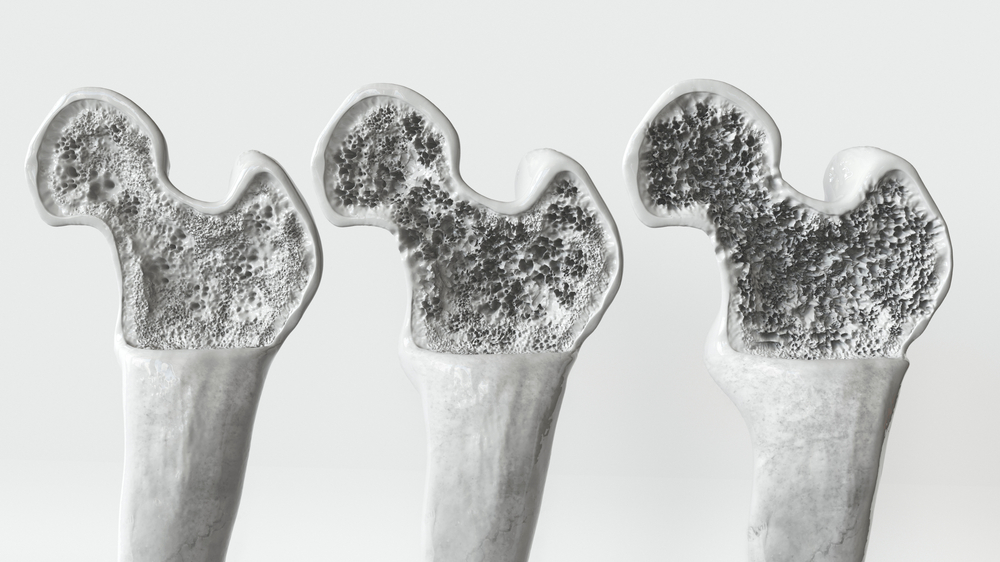
What Is Osteoporosis and What Can You Do about It?
Osteoporosis is a serious health condition in which bones weaken and are subject to breakage even by minor stresses like a fall or coughing. Although anyone can develop osteoporosis, it is most frequently found in white and Asian women who have passed menopause.
There are many ways to treat osteoporosis, but the most common include medications, healthy diet, and exercise. Because osteoporosis is related to a lack of calcium, most medical treatments will focus on raising the level of this mineral.
Causes
To understand what causes osteoporosis, you must have some knowledge of how bone is formed. Although it possesses some inorganic materials, namely calcium, that give it such hard rigidity, bone is actually living tissue. Bone is constantly being grown and torn down throughout our lives.
However, the rate at which this bone replacement occurs varies as we age. It is fastest when we are young which is why our bone mass is greatest at about age 30. After this point, our bone renewal rate declines, and out bones weaken.
It is important to know that your likelihood of developing osteoporosis is dependent on many factors, but one of the most significant is how much bone density you had in your youth. If you had stronger, denser bones, then you are less likely to experience a significant reduction in bone density later in life.
There are some other risk factors that can elevate your likelihood of developing osteoporosis.
- Gender—you are more likely to encounter osteoporosis if you are a woman.
- Age—the older you are, the higher your risk of osteoporosis.
- Race—Asian and Caucasian people are more likely to develop osteoporosis.
- Genetics—if you have a close family member with osteoporosis, you are also more likely to develop this condition.
- Smaller stature—people with smaller frames are more likely to have osteoporosis because they have less bone mass to begin with.
There are many potential causes for osteoporosis.
- Menopause—women who have completed menopause are at greater risk because the lower levels of estrogen make bones more brittle. Similarly, men with lower levels of testosterone are also more likely to develop osteoporosis.
- Hormonal issues—too much thyroid hormone has been linked to reduced bone density. Similarly, elevated activity of the parathyroid and adrenal glands may also raise this risk.
- Calcium deficiency—people who lack sufficient levels of calcium in their diet are at much higher risk of developing osteoporosis. Related to this is vitamin D which is essential in the absorption of calcium.
- Eating disorder—if you have an eating disorder like anorexia or bulimia that significantly reduces your nutritional intake, this will negatively affect your bone density.
- Gastrointestinal surgery—surgeries that limit the absorptive ability of your stomach or intestines can curtail your intake of key nutrients like calcium and vitamin D.
- Steroids—this medication can inhibit bone replenishment.
- Lack of physical activity—bone is more rapidly replaced when it is under slight stress like weight-bearing exercise.
- Tobacco use—because smoking inhibits your body’s ability to use calcium, vitamin D and estrogen, smokers are at greater risk of brittle bones.
- Health conditions—many health conditions can limit the uptake of calcium and other key nutrients including cystic fibrosis or cancer.
- Alcohol use—drinking alcohol can slow bone remodeling and accelerate the excretion of calcium.
How to Correct Osteoporosis
Just a few short years ago there were relatively few treatment options for osteoporosis, but there has been a surge in the number of therapies available in recent years. Before you ask your physician for the most advanced osteoporosis therapies, however, you should discuss the current state of your health. Many of these treatments carry some health risks that you should avoid unless your osteoporosis has progressed too far.
- Bisphosphonates—prescribed often for post-menopausal women, bisphosphonates slow the process in which existing bone is broken down. Although these medications may help people over the short term—in the first five years—they may raise the risk of a fracture if taken too long. There are also serious side effects for some that include intense bone, muscle, or joint pain as well as jaw necrosis.
- Monoclonal antibodies—this therapy is intended to treat patients with severe osteoporosis with a high risk of a fracture. The mechanism of this treatment involves neutralizing osteoclasts, a cell essential in bone resorption. Unfortunately, osteoclasts also play a key role in the immune system, so undergoing this treatment can raise the risk of certain kinds of infections.
- Teriparatide and abaloparatide—both compounds are derived from human parathyroid hormone accelerate the formation of new bone. It is important to note that these are very expensive medications—up to $20,000 annually—and their ability to prevent a fracture is only about 2 to 4 percent. There is also the potential risk of bone cancer.
- Menopause hormone therapy—this therapy adds estrogen or progestin, hormones that decline following menopause. Although this does add bone mass, there is an elevated risk of breast cancer, heart attack and stroke.
- Weight-bearing exercise—physical activity like walking, running, or dancing can improve bone density. Tai Chi, an ancient Chinese martial art that is performed in slow motion, has been shown to be quite effective at stimulating bone growth.
- Diet—because osteoporosis is primarily about a lack of calcium in the body, osteoporosis sufferers should eat a diet that will optimally replenish this and other key nutrients. Of course, this should include foods like milk and cheese that are rich in calcium and vitamin D, but it should include eggs, fish and poultry which have high levels of vitamin B. if you are a woman 50 years or older, or a man 70 years or older, then you should get 1,200 milligrams of calcium per day. Try to get your calcium from food rather than supplements; if you do want to take calcium supplements, ask your doctor first so that they don’t interfere with other medications that you are taking.
Article written by: Dr. Robert Moghim – CEO/Founder Colorado Pain Care
M.D. Disclaimer: The views expressed in this article are the personal views of Robert Moghim, M.D. and do not necessarily represent and are not intended to represent the views of the company or its employees. The information contained in this article does not constitute medical advice, nor does reading or accessing this information create a patient-provider relationship. Comments that you post will be shared with all visitors to this page. The comment feature is not governed by HIPAA, and you should not post any of your private health information.



